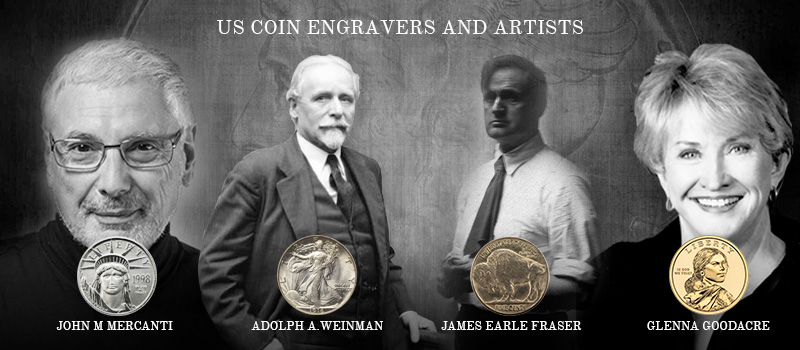US coin engravers and artists - Part 2

The second post in the series US coin engravers and artists is here
Adolph Weinman
Though Adolph A. Weinman preferred calling himself an architectural sculptor, in numismatic circles, he is best remembered as the man behind the beautiful Walking Liberty Half dollar design. Born in Germany, Weinman moved to the United States at the age of 14. He studied sculpting under great names like Augustus Saint-Gaudens and Philip Martiny. In 1916, designs of the dime, cent and half dollar were modified (More about thathere), and based on a design competition, Adolph Weinmans designs were selected for the dime and the half dollar.
For the Walking dollar, Weinman portrayed a glorious Lady Liberty walking towards the rising sun, carrying branches of laurel and oak, symbolizing civil and military glory. This original half dollar by Weinman was considered one of the most beautiful U.S. coins. Weinmans Dime design had the winged Liberty in the obverse, but later came to be called the Mercury dime. The reverse had the 'Fasces' that symbolized war and justice, and an olive branch around it symbolized even though America was ready for war itpreferred peace.[1]
James Earle Fraser
James Earle Fraser was born in Winona, Minnasota. His formative years were completely shaped by his experiences in what was then a western frontier state. Fraser studied at the cole des Beaux Artsand the Acadmie Julian in Paris in the late 19th century. He worked under names like Augustus Saint-Gaudens and Richard Brock. He also taught at the 'Art Students League' of New York. HisEnd of the Trailsculpture of a Native American atop an exhausted horse about to be hurled over an unseen precipice was considered his career best and catapulted him to fame.
Fraser brought his empathy for the Native American cause into his coins as well. The Indian Head Nickel had a Native American head in the obverse and an American Bison in the reverse (More about thathere). While it was criticised at the time as it didn't strike well, the design has been praised and used much later in commemorative coins, the 2001 Silver Dollar and the $50 American Buffalo Gold coin.[2]
John M Mercanti
John Mercanti is the living legend of the US mint. He was a sculptor as well as the US mint Chief Engraver between 2006 and 2010. He is the only Chief Engraver who has more than 100 coin designs to his name. John Mercanti joined the US mint in 1974 as a sculptor-engraver and worked under different capacities till he was made Chief Engraver.
Among Mercanti's notable designs are the American Silver Eagle reverse, five (Pennsylvania, North Carolina, Arkansas, Iowa and West Virginia) US state quarters, the John Marshall commemorative dollar and the Platinum Eagle obverse. The Platinum Eagle obverse shows the 'Statue of Liberty' looking towards the future.[3]
Glenna Goodacre
Glenna Goodacre is the sculptor-artist who designed the obverse of Sacagawea Dollar. Goodacrestarted her career as a painter which gave her a unique insight into giving the appropriate expressions for hersubjects. Some of her most famous works are theVietnam Women's Memorial and theIrish Memorialfor Penn's landing in Philadelphia.
Goodacre designed the Sacagawea Dollar's obverse, showing Sacagawea with her child, the Shoshone guide to the Lewis and Clark expedition. Goodacre used a Native American girlRandy'L He-dow Teton as a model for creating the Sacagawea dollar.[4]
Thesecoin engravers and sculptor-artists have done incredible work designing beautiful coins that have given a glimpse of the history to us. Let's celebrate them as we do their coins.
References
- https://en.wikipedia.org/wiki/Adolph_Alexander_Weinman
- https://en.wikipedia.org/wiki/James_Earle_Fraser_(sculptor)
- https://en.wikipedia.org/wiki/John_Mercanti
- https://en.wikipedia.org/wiki/Glenna_Goodacre
This entry was posted in General on December 20, 2016 by lavanya kannan

Leave a comment